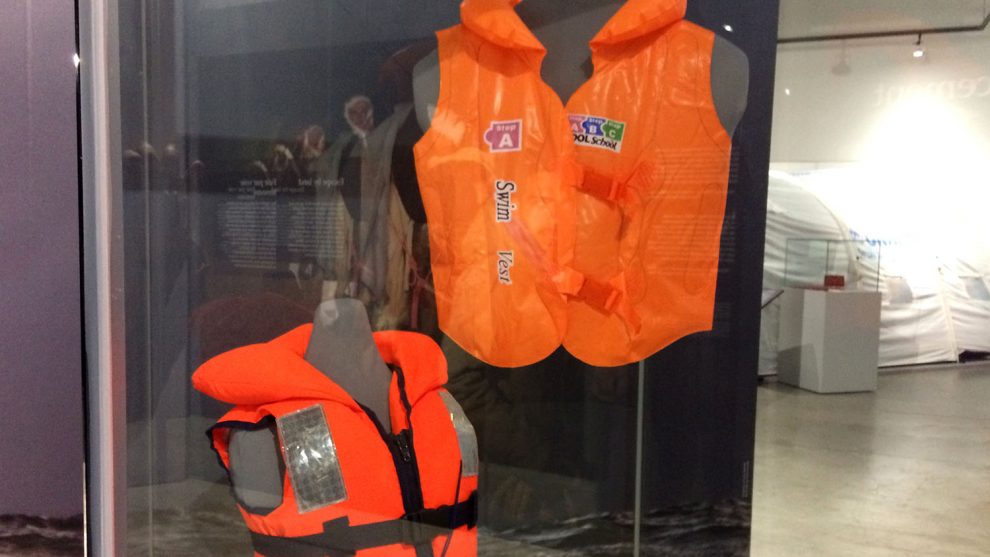Refugees
Refuge Canada exhibit a timely one, says curator
Museum curator reflects on success of Refuge Canada exhibit in its final week

caption
Museum curator Dan Conlin stands alongside a UNHCR tent featured in Refuge Canada exhibitRefuge Canada, an exhibit at the Canadian Museum of Immigration at Pier 21, will leave its home this Sunday for a cross-country tour. For museum curator Dan Conlin, the tour couldn’t have come at a better time.
“The world has the biggest refugee crisis since the Second World War that we’re grappling with in all kinds of ways,” said Conlin. “I think everybody’s thought something about refugees and this exhibit I think really responds to the things they’ve been wondering about or imagining.”
Refuge Canada debuted in Pier 21’s Ralph and Rose Chiodo Gallery on March 10. The exhibit re-created abandoned homes and featured artifacts, testimonies and interactive displays about the refugee experience.
One of Conlin’s favourite items is an authentic UN Refugee Agency tent. The plain white tent, furnished with several blankets and dishes, could be a family home for up to 18 years. Related stories

caption
Two life-jackets worn by child refugees rescued from an inflatable boat in the Mediterranean in 2015.Jennifer Powley, president of the Rainbow Refugee Association of Nova Scotia, said her visit to the exhibit was “moving.” She said she liked one particular interactive exhibit, which uses motion sensor technology. The sensors invited visitors to open three doors, revealing images that show the trauma refugees face.
Conlin credits the exhibit’s success to an experienced team of researchers and a collaboration with refugees and refugee advocacy groups, including the Halifax Refugee Clinic.
Creating an exhibit that also spoke to actual refugees was an important goal for Conlin. On the first day of the exhibit, he recalled a woman from the former Yugoslavia who was moved by how authentic the recreated apartments looked to those in Eastern Europe. Knowing that the exhibit rings true to these visitors assures Conlin that Refuge Canada is “doing the right thing.”
One of the first things you see in our #RefugeCanada exhibit @Pier21 is the "Before and After Living room": a familiar space turned upside down, looted and bullet-ridden to remind Canadians that anyone could become a refugee. Sunday Nov. 11 is your last day to see Refuge Canada. pic.twitter.com/zFhkY1cZZW
— Dan Conlin (@conlin_dan) November 9, 2018
Conlin said the temporary exhibit was created with two main goals. The first was to examine Canada’s track record in responding to refugee crises, a record which Conlin said is “mixed.”
He spoke highly of Canada response to the Syrian refugee crisis. He also warned that Canadians shouldn’t be smug about their country’s humanitarian history, and cited events such as the turning away of the MS St. Louis in 1939, a ship carrying Jewish refugees fleeing Nazi persecution.
“I think it’s important to look at some of these examples and try to avoid those past mistakes,” Conlin said.
Julie Chamagne, the executive director of the Halifax Refugee Clinic, praised Refuge Canada for its introspective look at Canada’s checkered refugee past.
“It certainly makes you think critically about Canada’s successes, but also about Canada’s failures,” said Chamagne.
The exhibit’s second goal was to help visitors better understand the refugee experience and, as Conlin said, provide refugees with a sense of agency. He hopes the exhibit showed that refugees are more than helpless victims and taught people about the difficult decisions these people face on a daily basis.
Conlin didn’t have an official figure for the number of visitors to the exhibit, but pointed to positive reviews on TripAdvisor and in museum comment cards as a mark of success.
“This exhibit, I think, has got the most powerful reaction of any temporary exhibit we’ve ever done,” said Conlin.
The next stop for Refuge Canada will be in Ontario. After that, the exhibit will move west across Canada before eventually working its way back east. The entire tour is expected to last five years.

